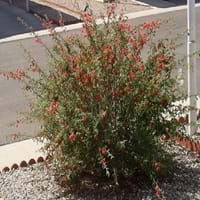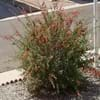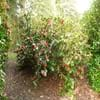Life Span
Perennial
Biennial and Perennial
Origin
Mexico
Europe, Western Asia
Types
Not Available
Not Available
Habitat
gardens, Grassland, Roadsides
waste ground, wastelands
USDA Hardiness Zone
9-14
4-9
Sunset Zone
10, 11, 12, 13, 14, 15, 16, 17, 18, 19, 20, 21, 22, 23, 24
A1, A2, A3, H1, H2, 1a, 1b, 2a, 2b, 3a, 3b, 4, 5, 6, 7, 8, 9, 10, 11, 12, 13, 14, 15, 16, 17, 18, 19, 20, 21, 22, 23, 24
Habit
Arching/Fountain-shaped
Rosette/Stemless
Flower Color Modifier
Not Available
Bicolor
Fruit Color
Brown, Light Green, Tan
Brown, Black
Leaf Color in Spring
Green
Green
Leaf Color in Summer
Green
Green
Leaf Color in Fall
Green
Green
Leaf Color in Winter
Green
Not Available
Leaf Shape
Pinnate
Pinnate
Plant Season
Spring, Fall
Summer
Sunlight
Full Sun, Partial Sun
Full Sun
Growth Rate
Medium
Medium
Type of Soil
Loam, Sand
Loam
The pH of Soil
Acidic, Neutral, Alkaline
Neutral
Soil Drainage
Well drained
Well drained
Bloom Time
Spring, Fall
Summer
Tolerances
Drought
Drought
Where to Plant?
Ground, Pot
Ground, Pot
How to Plant?
Seedlings, Vegetative Reproduction
Seedlings
Plant Maintenance
Medium
Medium
Watering Requirements
Do not water excessively, Prefer drip-irrigation instead of Over-head watering, Water Deeply
Average Water Needs, Do Not over Water, Keep the ground moist but not water-logged
In Summer
Lots of watering
Lots of watering
In Spring
Moderate
Moderate
In Winter
Average Water
Average Water
Soil pH
Acidic, Neutral, Alkaline
Neutral
Soil Type
Loam, Sand
Loam
Soil Drainage Capacity
Well drained
Well drained
Sun Exposure
Full Sun, Partial Sun
Full Sun
Pruning
Remove damaged leaves, Remove dead branches, Remove dead leaves
Remove damaged leaves, Remove dead branches, Remove dead leaves
Fertilizers
All-Purpose Liquid Fertilizer
All-Purpose Liquid Fertilizer
Pests and Diseases
Red blotch
Aphids, Armyworm, Cutworms, Downy mildew, Pitch canker, Red blotch
Plant Tolerance
Drought
Drought
Flower Petal Number
Single
Not Available
Fragrant Bark/Stem
No
Yes
Foliage Texture
Medium
Fine
Foliage Sheen
Matte
Matte
Attracts
Hummingbirds, Butterflies
Butterflies
Allergy
Not Available
Stomach burn
Aesthetic Uses
Beautification, Showy Purposes
Not Available
Beauty Benefits
Not Available
Blood purifying, Good for skin
Environmental Uses
Air purification
Air purification
Medicinal Uses
Not Available
Aphrodisiac
Part of Plant Used
Flowers
Root
Other Uses
Showy Purposes
Food for animals, Used as a nutritious food item
Used As Indoor Plant
No
Yes
Used As Outdoor Plant
Yes
Yes
Garden Design
Hedges, Mixed Border, Screening, Tropical, Wildflower
Edible, Herb, Vegetable
Botanical Name
CALLIANDRA californica
PASTINACA sativa
Common Name
Baja fairy duster
Zapotillo
Chuparosa
Parsnip
In Hindi
tabardillo
चुकंदर
In German
tabardillo
Pastinake
In French
tabardillo
Panais
In Spanish
tabardillo
Chirivía
In Greek
Tabardillo
Είδος δαυκίου
In Portuguese
Tabardillo
cherivia
In Polish
Tabardillo
Pasternak
In Latin
Tabardillo
parsnip
Phylum
Magnoliophyta
Magnoliophyta
Class
Magnoliopsida
Magnoliopsida
Clade
Angiosperms, Eudicots, Rosids
Angiosperms, Asterids, Eudicots
Tribe
Not Available
Not Available
Subfamily
Not Available
Not Available
Number of Species
Not Available
Not Available
Season and Care of Tabardillo and Parsnip
Season and care of Tabardillo and Parsnip is important to know. While considering everything about Tabardillo and Parsnip Care, growing season is an essential factor. Tabardillo season is Spring and Fall and Parsnip season is Spring and Fall. The type of soil for Tabardillo is Loam, Sand and for Parsnip is Loam while the PH of soil for Tabardillo is Acidic, Neutral, Alkaline and for Parsnip is Neutral.
Tabardillo and Parsnip Physical Information
Tabardillo and Parsnip physical information is very important for comparison. Tabardillo height is 90.00 cm and width 120.00 cm whereas Parsnip height is 15.20 cm and width 7.60 cm. The color specification of Tabardillo and Parsnip are as follows:
Tabardillo flower color: Red
Tabardillo leaf color: Green
Parsnip flower color: Yellow
- Parsnip leaf color: Green
Care of Tabardillo and Parsnip
Care of Tabardillo and Parsnip include pruning, fertilizers, watering etc. Tabardillo pruning is done Remove damaged leaves, Remove dead branches and Remove dead leaves and Parsnip pruning is done Remove damaged leaves, Remove dead branches and Remove dead leaves. In summer Tabardillo needs Lots of watering and in winter, it needs Average Water. Whereas, in summer Parsnip needs Lots of watering and in winter, it needs Average Water.





